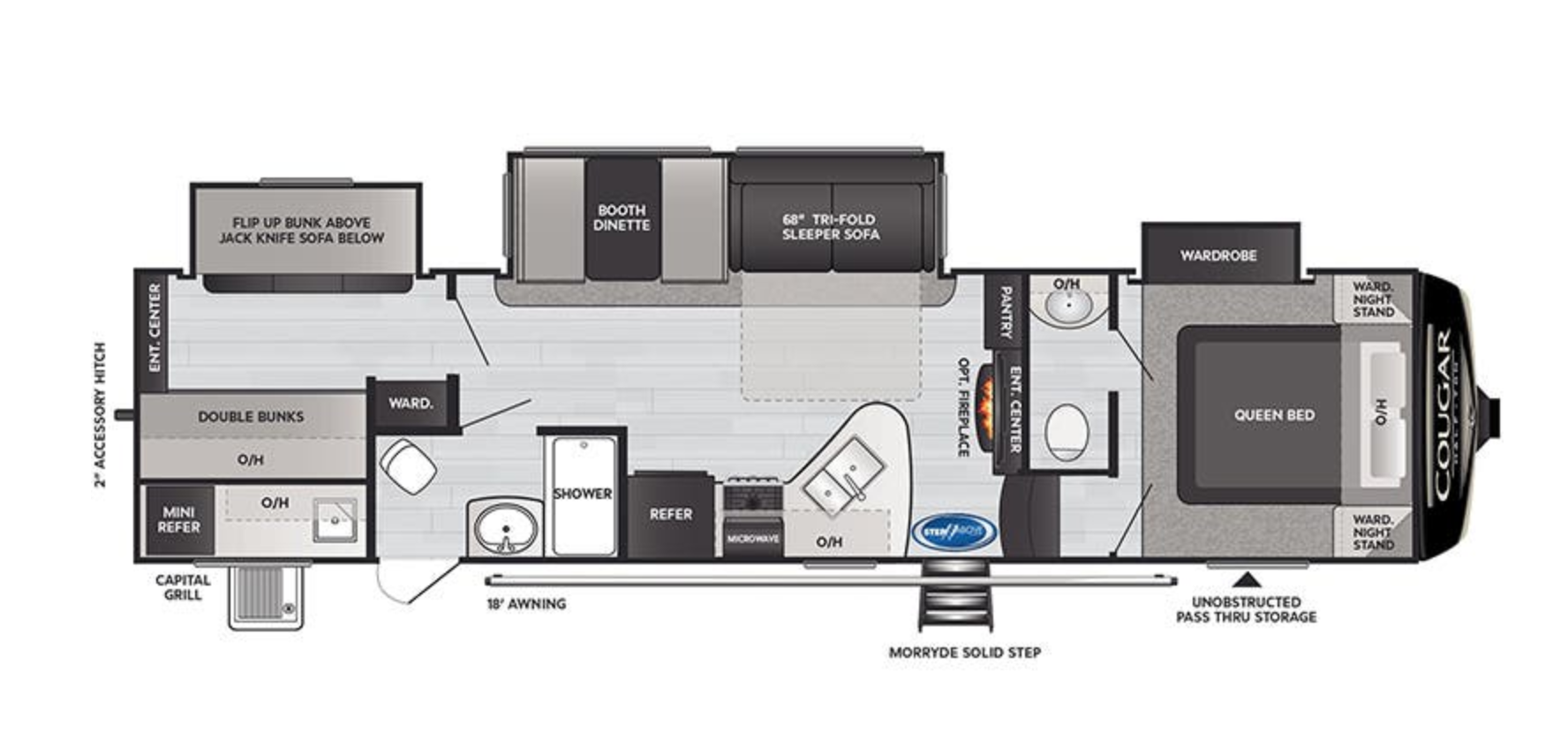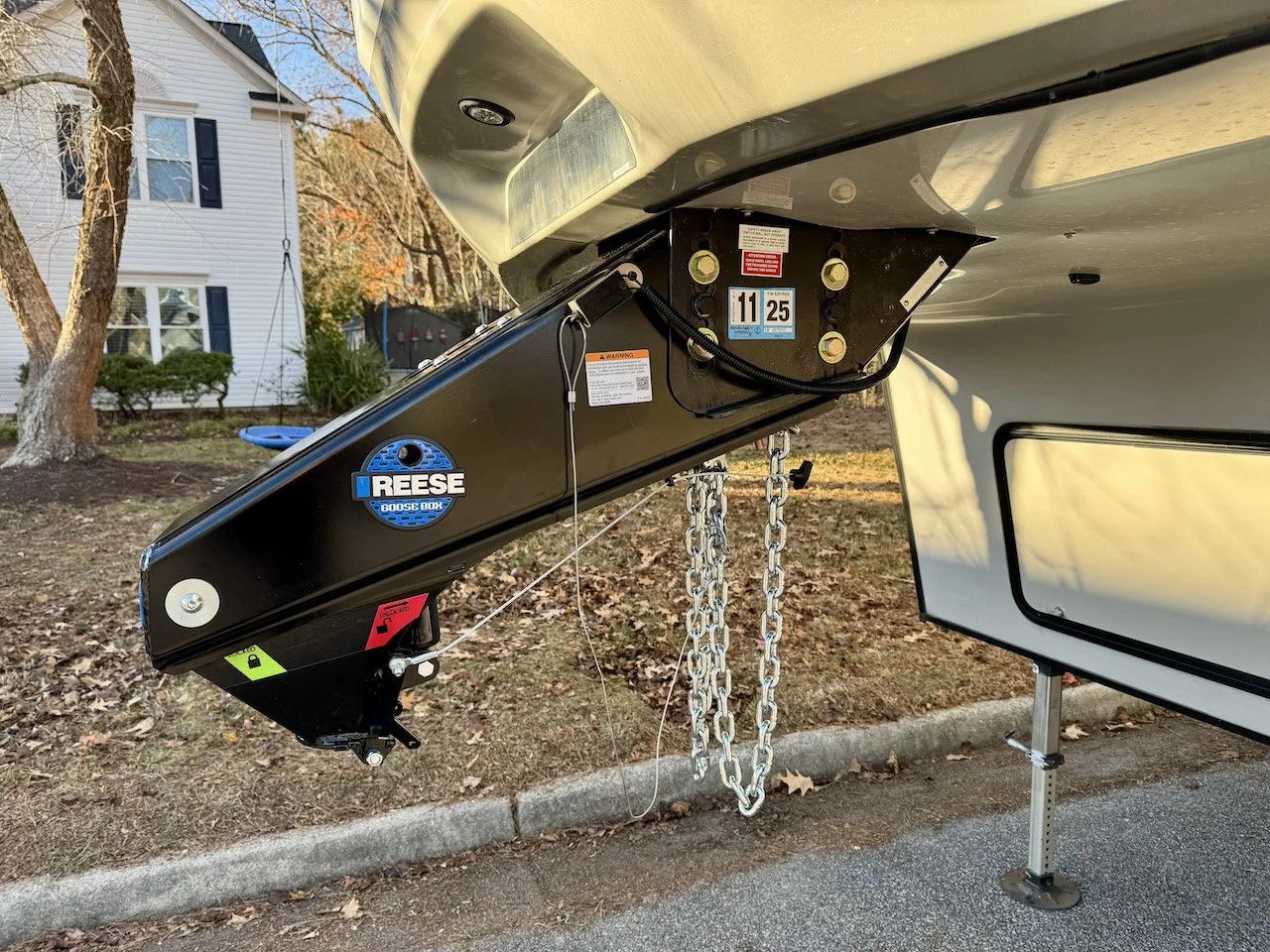Our Home on Wheels: Top 10 Truck and RV Modifications
How we turned our mediocre factory-issued rig into a badass road-tripping machine.
One of the things I love and appreciate about Nick is that he doesn’t accept the mediocre fate of factory standards for gear and equipment. He modifies and optimizes, muscling out any inefficiencies and inadequate concept designs.
This played out early in our marriage/his Navy career when he asked me to teach him how to use my Bernina sewing machine. Unlike me, he wasn’t in it for making custom curtains for our first apartment. He wanted to modify his kit—the vest issued to hold his tools, weapons, and body armor.
Once he got the hang of maneuvering the sewing machine’s needle, peddle, and foot, he repositioned straps and pockets on the vest and sewed Velcro where he wanted it. His modifications turned out to be the envy of his BUD/S class. Before I knew it, a platoon’s worth of future Navy SEALs visited our tiny apartment to borrow my Bernina so they could modify their kits, too.
Those of you reading this who have worked or served with Nick probably recognize and appreciate this quality about him as well. He is wired for improvement and doesn’t stop pushing the needle until previously ineffective systems are highly optimized for efficiency and output. I’ve seen him use his skills for everything from paring down our sailboat’s underway procedures (to a lightening-quick four minutes) to restructuring a government division of 100+ military and civilian employees.
This brings us back to our fifth wheel, which was not to Nick’s standards. The mediocre construction of typical RVs combined with our plan to travel for an entire year put Nick’s optimization skills into overdrive. To give you an idea of what he’s been up to in his free time the past few years, these are the top 10 most trip-enhancing modifications he’s made to customize the truck and trailer.
The layout of our Keystone Cougar 32BHS fifth wheel (except ours had recliners instead of the sleeper sofa).
10 - Putting walls to work for storage:
For starters, above is the layout of our Keystone Cougar 32BHS trailer. At 36’ long, this fifth wheel is the smallest and lightest we could find that has an additional half bathroom—a feature we knew would be crucial to our happiness living together in a small space for an entire year.
In this model, Keystone built an RV that technically sleeps eight people. But they only put one towel hook in one bathroom. So, one of the first modifications Nick made was to make and hang towel hooks—not just for shower towels, but for beach towels and coats as well.
Once we moved into the trailer, he kept going with additional 3M sticky hooks for hats, visors, keys, hoodies, and bags. Not only does hanging things keep items out of our precious cabinet/drawer space, it also makes these items easy to track and grab. So, as far as this modification goes, I guess you could say we’re hooked.
9 – Shoe Storage: Dear Keystone, please explain why you made sleeping space for eight but nowhere for shoes? Thankfully Nick poked around and found this dead space beneath the electric fireplace. He used a jigsaw to cut out this spot where we can each keep a pair of shoes ready to go but out of the way.
Modification in progress
Modification complete.
8 – Outdoor kitchen converted to garage
A popular feature of many RVs is an outdoor kitchen. In theory, these are great for hosting/entertaining without friends crowding a tight indoor living area. I’m sure the outdoor mini fridge and gas griddle are wonderful for tailgates and parties.
Outdoor kitchen converted into a garage
What we needed, however, was somewhere to securely store Nick’s carbon fiber mountain bike and other adventure gear. After removing the fridge, he installed brackets with rubber-coated wire ties in the ceiling to hang the bike. The reclaimed outdoor kitchen space is a great storage garage for helmets, tools, workout equipment, climbing gear, and other outdoor rec gear.
The rest of our bikes are slumming it over the open road on the trailer’s hitch mounted rack. But Nick’s mountain bike landed valet parking in a private garage.
7 - Bedside reading lights: The factory installed bedside lighting is obnoxiously bright and poorly placed. It shines down on your head, which casts a shadow onto your page. Not ideal.
Nick installed adjustable bedside reading lights that can be positioned to shine over your shoulder and illuminate your page for a perfect cozy reading experience <swoon>.
5 and 6 – Recliner/couch swap and bin storage area. The kids’ bunk room came with three bunks and a jack-knife couch that pulls out for a fourth person to sleep on. Our living room came with a double recliner set that only allowed two people to sit down at once.
Before - Two heavy recliners
After - One couch plus large storage area beneath and behind it
One GOOD thing about the way these rigs were built is the modular design: the jackknife couch is the exact same length as the recliners. Nick removed the living room recliners from the trailer and installed the couch from the kid’s room there instead. Now our whole family of four can sit on it comfortably.
Bonus: He installed the sofa away from the wall, leaving us with a bounty of additional storage near the entrance. This bonus spot behind the sofa is the perfect place to keep bulky items like inflatable paddleboards, a soft Yeti cooler, grocery bags, and beach supplies. Beneath the couch, we’re able to store beach towels and shoes.
#5 and 6 are combined because the couch’s spot in the bunkhouse created the additional space for a new storage area for bins of gear. These bins are holding our hiking gear, balls/frisbees, and homeschool stuff/books.
The large opening allowed us to bring a truly comfortable chair. Nick installed a fold-out desk in case someone needs a quiet place to do schoolwork or take a call. (We’re both currently enjoying not being invited to any work calls.)
Before: Sofa below
After: Bins galore
4 - 60-gallon fuel tank. Nick’s F-250 came with a standard 34-gallon diesel fuel tank. Trouble is when you’re getting about 10 mpg and driving 300+ miles on drive days, this means filling up constantly. Getting gas might not sound like a big deal, but filling your diesel tank when you’re towing a 36’ long, 13’ tall trailer that weighs 11,000 lbs can be difficult, especially if you’re not at a truck stop designed for tall and long vehicles. The 60-gallon fuel tank means we’re not constantly hunting for fuel stations, and we have more flexibility to make it to discounted fuel stations. We use the Open Roads fuel card and usually save 10-50 cents per gallon off of the pump price at select stations.
This upgrade to the truck is a holdover from our first travel trailer. Nick changed out the fuel tank himself in the parking lot of family housing at Stanford in 2021. We’ll never know for sure, but he might hold the record for first Stanford student to ever change a vehicle’s fuel tank on campus grounds.
Not pictured: Several confused looks from Stanford students passing by in the parking lot.
3 - Hydraulic disk brakes (trailer). The fifth wheel came with electric drum brakes, which is standard—and also the cheapest. The problem with this braking system is there’s a significant delay from when you press the brake pedal in the truck to when you feel the trailer actually stopping.
Hydraulic brakes (right three pics) stop the trailer in about 30% shorter distance, which is why hydraulic disk brakes are on every modern vehicle and high-end bicycles. They’re just superior—and most importantly, safer.
Like all of the modifications listed here, Nick installed the brake system himself. This involved taking off the old electric drums and hubs, installing a hydraulic brake actuator at the front of the trailer and wiring it into the trailer’s electrical system, running the hydraulic tubing from the actuator to all four wheels, installing the disc brackets, packing the bearings and installing the new rotors, and then bleeding the system. (Can you tell which part of the post Nick typed himself?) Testing the system out on steep grades is one of the main reasons we went to West Virginia for spring break. The hydraulic brakes were a huge improvement and boosted our confidence for safe driving in the mountains.
2 - Goosebox hitch. Our former Anderson hitch looks like this, weighs about 45 lbs, and takes up a LOT of truck bed space.
Nick swapped it out for a Goosebox hitch, which connects the fifth wheel to a gooseneck ball in the bed of the truck. The hitch has an air bag system built in, which provides additional cushion for the 11,000 lbs. riding behind us and, ultimately a much smoother ride.
Another great benefit of this hitch setup is that when we’re not towing, the tow ball can be easily stored, and we have complete use of the truck bed for transporting gear like bikes and paddleboards. A smoother ride + easier access to fun = massive win.
What’s good for the Goosebox
See also: good for the truck bed
And finally, our #1 most life-changing RV modification is…
1 - Reverse osmosis water purification system. For the previous five years as RV-ers, we’ve hauled gallon jugs of water with us. We were constantly buying, storing, and monitoring our drinking water.
Hands down the most life-changing modification has been the reverse osmosis water purification system. This tankless water filtration system has an alkaline remineralization filter and a UV sterilizer that removes 99.99% of contaminants and micro-organizms. All good stuff.
It’s connected to the water supply line under the kitchen sink and goes to its own drinking water tap at the sink. Now a simple pull of the lever brings clean, sanitized, and great-tasting drinking water regardless of whatever impurities may be lurking in the campground’s water. (Massive win.) We use the system for filling water bottles and ice trays, washing produce, and cooking.
If you’ve stuck around this long, you are a very good friend :) I’ll leave you with one final creative effort that isn’t technically a modification so it didn’t make the list:
Nick in search of an underutilized storage space to stash our skis. (It will surprise no one that he found one).
Epic pass holders, come join us out west this winter.
For those just finding us, hello! Inspired by the Year of Jubilee in Leviticus 25, our family is embarking on a yearlong RV road trip in 2025-26 to celebrate my husband’s retirement after 20 years in Naval Special Warfare and our 24 years together through ten commands, eight deployments, and six duty stations. We hope this trip will give us space to reset and reflect before civilian life begins.
Sign up below to receive updates about the trip, along with stories and reflections from 24 years of wartime military service. We look forward to keeping in touch on this epic adventure.
To join the Road Trip email list, please fill out this short form. We promise no spam and an AI-free zone. Any typos and mistakes are my own :)
For background info on who we are and where we’re traveling, we’d love for you to read the intro post. Thanks for stopping by!























